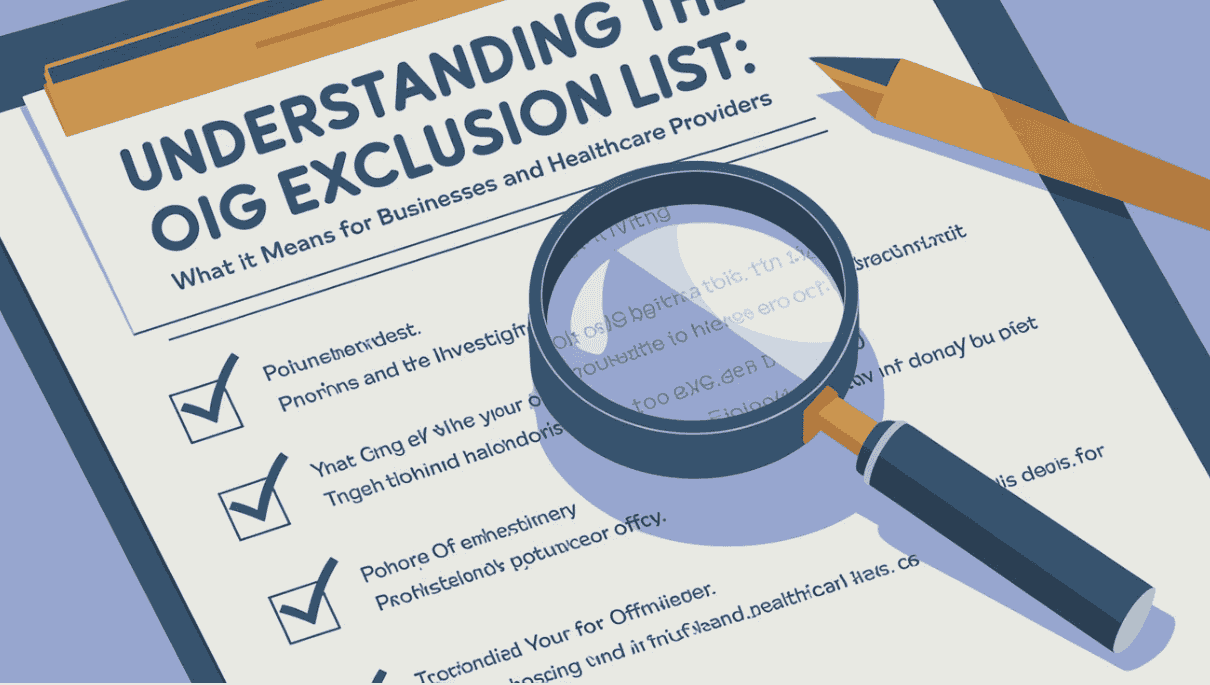Understanding the OIG Exclusion List: What It Means for Businesses and Healthcare Providers
Introduction
The Office of Inspector General (OIG) Exclusion List is a crucial regulatory tool used to prevent fraud, waste, and abuse in federally funded healthcare programs such as Medicare and Medicaid. Individuals or entities found guilty of fraudulent activities, patient neglect, or other offenses related to healthcare services may be excluded from participating in these programs.
This article explores the OIG Exclusion List, its implications, how businesses can ensure compliance, and the process of reinstatement for those who have been excluded.
What Is the OIG Exclusion List?
The OIG Exclusion List, formally known as the List of Excluded Individuals and Entities (LEIE), is maintained by the U.S. Department of Health and Human Services (HHS). It includes individuals and entities that are prohibited from participating in federally funded healthcare programs due to violations such as:
Medicare or Medicaid fraud
Patient abuse or neglect
Licensing board disciplinary actions
Criminal convictions related to healthcare services
Drug or medical device-related crimes
The OIG regularly updates this list, and all healthcare providers, insurance companies, and other organizations that receive federal funds must check it to ensure they are not employing or contracting with excluded individuals or entities.
Who Can Be Placed on the OIG Exclusion List?
Exclusions fall into two main categories:
1. Mandatory Exclusions
Certain offenses automatically result in exclusion from participation in federal healthcare programs for a minimum of five years. These include:
Convictions related to Medicare or Medicaid fraud
Patient abuse or neglect
Felony convictions involving controlled substances
Financial misconduct related to healthcare services
2. Permissive Exclusions
The OIG has discretion over permissive exclusions, which can be based on:
Misdemeanor convictions related to fraud
License revocation or suspension
Participation in illegal kickback schemes
Submitting false healthcare claims
Consequences of Being on the OIG Exclusion List
Being listed on the LEIE carries severe consequences for both individuals and businesses:
1. Financial Penalties and Fines
Employers who hire or contract with an excluded individual risk heavy fines and potential loss of federal funding.
2. Loss of Medicare and Medicaid Reimbursement
Excluded individuals and businesses cannot receive payment from federal healthcare programs, making it difficult for them to operate within the industry.
3. Reputational Damage
An OIG exclusion can lead to serious reputational harm, making it harder to find employment or business opportunities in the healthcare sector.
4. Legal Consequences
Organizations that fail to check the OIG Exclusion List and employ excluded individuals may face legal action and additional sanctions.
How to Check the OIG Exclusion List
Healthcare providers and businesses must regularly check the OIG Exclusion List to ensure compliance. Here’s how:
Visit the OIG Exclusions Database
The List of Excluded Individuals and Entities (LEIE) is available on the OIG website (https://exclusions.oig.hhs.gov).
Use the OIG Search Tool
You can search by name or National Provider Identifier (NPI) to check for exclusions.
Perform Monthly Checks
The OIG updates the list monthly, so organizations should conduct regular screenings of their employees and vendors.
Use Third-Party Compliance Services
Many businesses use automated exclusion screening services to stay compliant and avoid costly fines.
How to Get Removed from the OIG Exclusion List
If an individual or entity is excluded, they must follow a formal reinstatement process after the exclusion period ends. Here’s how:
Submit a Reinstatement Application
Contact the OIG Exclusions Unit and request a Reinstatement Application.
Provide Supporting Documentation
Submit documents showing compliance with any requirements, such as regaining a medical license.
OIG Review Process
The OIG will review the application and conduct an investigation before making a decision.
Receive a Reinstatement Decision
If approved, the individual or entity will receive an official letter confirming their removal from the LEIE.
Conclusion
The OIG Exclusion List is an essential safeguard for the healthcare industry, protecting patients and federal healthcare programs from fraud and misconduct. Employers and healthcare providers must conduct regular screenings to avoid hiring excluded individuals and face legal or financial penalties.
For those who have been excluded, reinstatement is possible but requires a structured process and compliance with OIG regulations. Ensuring adherence to OIG compliance standards not only protects businesses but also maintains the integrity of healthcare services in the U.S.









